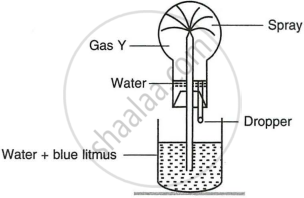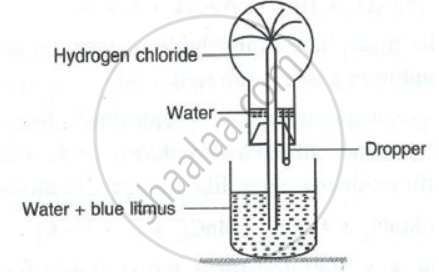Advertisements
Advertisements
प्रश्न

The diagram shows an apparatus for the laboratory preparation of hydrogen chloride.
(i) Identify A and B
(ii) Write the equation for the reaction
(iii) How would you check whether or not the gas jar is filled with hydrogen chloride?
(iv) What does the method of collection tell you about the density of hydrogen chloride.
उत्तर
(i) A = conc. H2SO4 B = NaCl
(ii) \[\ce{NaCl + H2SO4 -> NaHSO4 + HCl}\]
(iii) When a rod dipped in ammonium hydroxide is brought near the mouth of the gas jar, dense white fumes of ammonium chloride are produced.
(iv) Hydrogen chloride is denser than air.
APPEARS IN
संबंधित प्रश्न
When dilute HCl is added to a salt Q, a brisk effervescence is produced and the gas turns lime water milky.
When NH4OH solution is added to the above mixture (after adding dilute HCl), it produces a white precipitate which is soluble in excess NH4OH solution.
The aim of the Fountain experiment is to prove that ______.
Study the figure given below and answer the questions which follow:

- Identify the gas Y.
- What property of gas Y does this experiment demonstrate?
- Name another gas which has the same property and can be demonstrated through this experiment.
Name the following:
Gas obtained by treating metals with hydrochloric acid.
Name the drying agent used to dry HCl gas.
Choose the correct answer from the options given below: HCl gas can be prepared by direct combination of hydrogen and chlorine gas in presence of
How will you show that hychloric acid contains both hydrogen and chlorine (other than by electrolysis) ?
Give reason for the following:
Dilute hydrochloric acid cannot be concentrated by distilling (boiling) the dilute acid.
The following question is pertaining to the laboratory preparation of hydrogen chloride gas.
Write the equation for its preparation mentioning the condition required.
- Name the experiment illustrated below.
- State the colour of the water that has entered the round-bottomed flask.

